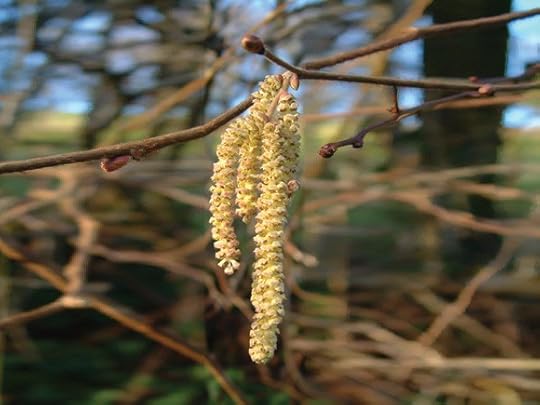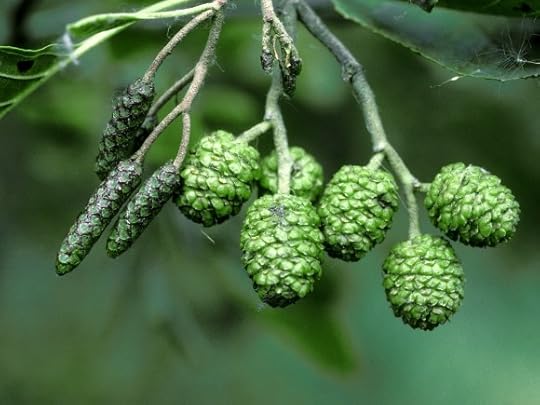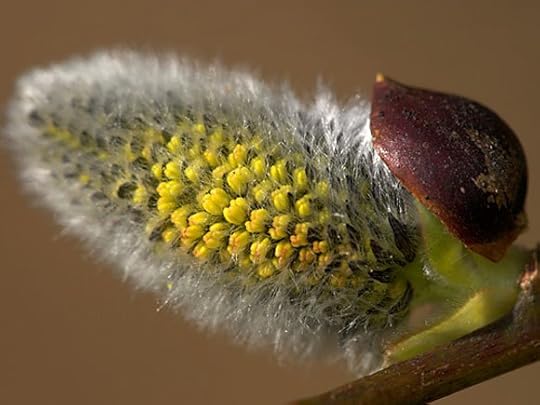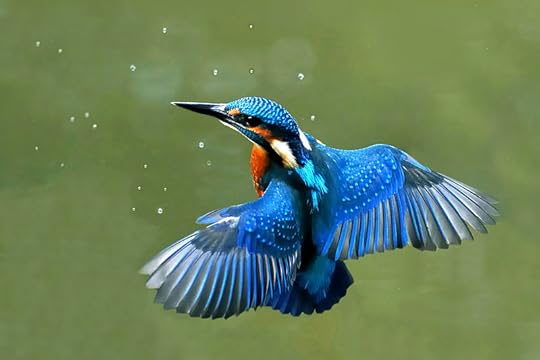Nimue Brown's Blog, page 298
January 13, 2017
The reality of omens
When looking for omens in the world around us, it is necessary to consider how reality works in the first place. One of the things I have rejected outright is that other autonomous beings could show up in my life as messages from spirit – because the idea that a hare, a sparrowhawk, or some other attention grabbing thing could have its day messed about purely to try and give me a sign, is profoundly uncomfortable to me. I have something of an animist outlook, and I do not think the universe is *that* into me.
At the same time, influenced by a number of spiritual traditions and myths, I have a sense of the universe as an unfolding thing – a river, a cloth – I don’t know. Something complex, flowing, and with the past informing the future. In that great flow, signs of the flow may emerge like ripples in the stream.
The conclusion I’ve come to is that the best place to look for such ripples is in random things that probably don’t have intent of their own. The behaviour of a moustache is a family favourite. The shape of a bird poo, the patterns made by random natural things, especially if they look a bit like something else. Clouds are great fun for this.
I’ve also come to the conclusion that an amazing encounter with nature can be read in other ways. I saw an otter in town recently. I think the otter was minding its own business, but I can read a number of things into the sighting. It tells me very clear things about the health of my local streams and rivers, it tells me I live in a good place, and that there are reasons to be hopeful. The otter was not bearing this message to me, it is simply what it means in this context, and anyone seeing it could infer the same.
I can however read something into my behaviour at this point. I was in the right place at the right time, and I think that tells me something about my relationship with the flow. I take exciting nature encounters as good omens not because I think nature is bringing me a special message, but because it means I was in just the right place, at exactly the right time, looking the right way and paying attention. That in turn means I am in tune, and would seem to bode well for anything else I’m doing


January 12, 2017
Time Takes a Cigarette 1
This is a series of flash fictions, which I head the pleasure of hearing read out back in December. A wholly unpredictable piece of work, imaginative, beautifully written… I’m reblogging the first installment, there are 12 in all so do get in there and keep reading – you might want to grab a cup of something and save it for a break, but as the installments are short, it will not occupy a crazy amount of your time.
 1. Hogmanay. The Royal Mile is rammed to the ginnels. They’re wavering by the Waverley. Getting bolloxed by John Knox House. Friends. Loved ones. Strangers. Japanese students in fake ginger beards …
1. Hogmanay. The Royal Mile is rammed to the ginnels. They’re wavering by the Waverley. Getting bolloxed by John Knox House. Friends. Loved ones. Strangers. Japanese students in fake ginger beards …
Source: Time Takes a Cigarette 1


January 11, 2017
Catkins: One of January’s true joys
The Pagan myth that nature is all asleep and quiet now and everything kicks off at Imbolc, is rather brought into question by the beautiful January phenomena that is the catkin. Catkins are the reproductive parts of some trees, they form in late autumn, and flower from January onwards. Thus far this year I have seen open catkins on hazels and alder, while the pussywillow is just starting to open.

Hazel catkins
Catkins are small and subtle, you won’t see them unless you get fairly close to the tree and look. But if you do, there they are! They tend to be male and female, and wind pollinated. Male hazel catkins are quite colourful, pussywillow invites stroking (hence the name) and they add a bit of cheer. They are also the promise of life to come, of hazel nuts, new trees, and everything else getting going as we move towards spring.

alder catkins
Nature never really sleeps, something is always happening. The trick is to get past our simplistic notions about what ‘nature’ is doing at any point in the year, and see what’s actually going on around us.

Pussywillow aka grey willow, although goat willow can also be called pussywillow and willows like to hybridize…
I have an alternative wheel of the year column over at Sage Woman blogs, so if you’d like a monthly prompt for things to celebrate that aren’t a tidy match for the regular wheel of the year narrative, do wander over – http://witchesandpagans.com/sagewoman-blogs/nimue-s-wheel.html
Images in this blog post come from the Woodland Trust website, find out more about trees and tree protection here – http://www.woodlandtrust.org.uk/


January 10, 2017
Bardic Skills: focus or diversify?
It’s impressive to do something well, and it is more impressive to do many things well. Thus the temptation can be to try and develop a vast array of skills, to write and recite poetry, and tell stories, and sing, and play four different musical instruments… Over time, having a broad skills base is a wholly realistic aim, but how much and how soon is worth pondering.
There are more advantages to diversifying than just looking good. If you just sing, a cold can wipe you out. Musical instruments do not benefit from going out in the rain. If there are four storytellers and you, choosing not to be a storyteller that day will help you stand out.
One significant risk of diversifying is that you end up being the sort of person who is forever starting new things, but never getting any of them anywhere. Picking up a new skill can be a way of not risking exposing yourself. You throw everything at the new thing, but never take it out because before you do, another new thing has come along. It can be a means for being really self-defeating while feeling like you’re making lots of progress and doing good work.
There are lots of very good reasons to focus on just one thing – not least being if you love that thing above all else. The person who invests all the time at their disposal in one discipline will move further and faster than a person with a more scattered approach. However, not all of us are psychologically cut out for that sort of focus and devotion – I’m not, I get bored easily, and so I can play several instruments passably, I can sing well enough, I’m an adequate sort of poet and a mediocre storyteller. But, I can usually find something to suit the situation, and I mostly get away with it.
It’s important to know who you are – obsessive or procrastinating, a one trick pony, an old dog with a hunger for new tricks… Who you are is the single biggest factor in deciding how much to focus and how much to diversify. That said, I recommend having one thing you’re invested enough in to feel confident and relaxed about, and at least one thing up your sleeve to cover for the times when what you normally do won’t really work.


January 9, 2017
Looking for kingfishers
This post will primarily be useful for people who live in regions inhabited by kingfishers. Wikipedia suggests that’s likely to be lots of you (https://en.wikipedia.org/wiki/Kingfisher ). However, there are wider issues here about seeing what’s actually there, and finding wildlife by getting to know what it does, so there should be some wider relevance.
The kingfisher, as the image demonstrates, is a brightly coloured bird that eats small freshwater fish. It seems reasonable to expect that it would therefore be easy to spot, and this (I think) is why many people don’t actually see them. Photos of kingfishers are misleading, as they most usually show the bird with the light catching it to really show off the iridescent colours of the plumage. Without the right lighting, the kingfisher is much more nondescript to look at. When motionless amongst plant life, the colour distribution breaks up the bird shape, and makes them surprisingly hard to spot. I’ve found it’s often the case that things that look colourful when presented in a book often blend in far more effectively than anticipated.

Kingfisher by Joefrei looking bright blue, in a way you will seldom see in real life.
The best place to look for kingfishers is at the margins of water. They can hunt from a few feet above the surface if there’s plants or a bank to sit on. When looking for fish they are fairly still, only the speculative tilting of the head will give them away, and that’s a pretty subtle movement. When they move, they move fast – a sudden plunge into the water and a rapid shift – often to a new perch. If you see the flash of flight and a streak of blue, you’ve probably got one. The trick is to keep looking at this point because the odds are the kingfisher hasn’t gone far and you can get a better look at it.
I have on numerous occasions now seen kingfishers in flight about a foot from the bank, low above the water. It’s a very rapid flight, and this often gives them away without a glimpse of colour. Spotting where they land and moving in for a closer look often delivers rewards. I’ve been able to get close to them repeatedly without bothering them – if they are somewhere people frequent, they can be very relaxed.
On occasion, kingfishers will hunt from higher perches – telephone wires across canals for example. Here it is the sudden, high speed dive that gives them away. I’ve also seen them in flight much higher and away from water – moving between bodies of water – here it’s the overall bird and beak shape that is most readily identified. They’re about the size of a blackbird, but have a longer beak by far.
Kingfishers are something a person is unlikely to see unless specifically looking for them. The speed of movement and the tendency to stay close to the bank and plant matter makes them hard to spot. If you are looking, and they are about, you will see them. They work quite large territories, so you won’t necessarily see them all the time, or on the first few tries. The kingfisher itself hunts with what looks to me like a combination of patience and curiosity. Its sits still, watching the water, waiting, paying attention. It strikes when ready, sometimes it gets a fish, sometimes not. Either way, it waits and tries again. A similar approach to looking for them has served me very well.


January 8, 2017
Seasonal Blues
It is a perfectly reasonable, human thing to struggle with the winter. The shorter days, often with far less sunlight mean those of us in the northern part of the earth are short of vitamin D. Some of us suffer seasonal affective disorder. For some, the cold, the treacherous footing, and the dark nights are a downer. This is the first year in ages where those dark nights haven’t been a real barrier to me having a social life, and that’s in no small part because I’ve now frequently got things to do of a Sunday afternoon.
For anyone whose finances are tight, winter adds extra pressure – for some it means a choice between heating and eating, for some even that choice isn’t available. This is an unkind season, an isolating season, a killing season. Many people roll out of the festive period into the harsh reality of increased debt at the start of the New Year.
I often find there’s a backlash after midwinter festivity – yes, in theory the light is returning, but it seems a long way off, it still gets dark early, it’s still cold, there are a good two months of this to come… but now there’s nothing much to look forward to. The feeling that it should be getting easier can contribute to actually feeling worse about it.
I’m luckier than many people because there are viable solutions for me. I can add colour, warmth and light as needed. I do now have the resources – financial and energetic – to connect with people at this time of year. I have places I can go and things I can do. But I’ve also been on the other side of this, cut off, cold, stuck, and without the resources to change any of it. That’s not a good place to be. If you know someone who could be isolated by this time of year, drop them a line, call them, if it makes sense to show up, show up. It can be a lifeline – in a practical sense and also emotionally.


January 7, 2017
Where is my Druidry?
Back when I was working on ‘When a Pagan Prays’ it struck me that it’s very easy to fall into a ‘my work is my prayer’ mentality, where there’s no real truth in the assertion. If my life is my Druidry, and my Druidry is intrinsic to my everyday life, then I am equally at risk of just doing whatever occurs to me and having no discernible Druidry in the mix at all. What makes it a Druid life?
I don’t have a fixed daily practice. I don’t have an altar at the moment. I’m not honouring any deities. I’ve felt for the last six months or so that my Druidry was in flux, and I’m entirely easy with that – it’s happened before and I both expect and hope that it will continue to happen.
I’ve lost several key community spaces this year – Druid Camp, and the Contemplative Druid meetings. I have become much more involved with a bardic community, which goes well with my desire to reconnect with and re-commit to the bardic path. I’ve invested more time in divination (I may be back to write about this in more detail) and as ever, walking, and being present in the world are a big part of what I do. My service has shifted – I’m no longer volunteering for OBOD, but am giving my time to The Woodland Trust instead. Last year there were more seasonal rituals than I’ve had for years, and I mean to carry on with that.
I don’t know where I am, I’m not entirely sure where or if I fit, and that’s fine. I don’t know where I’m going – there’d be no fun in it if I did. Journeys into land and story, maps and labyrinths, dreams and possibilities are part of my sense of trajectory, but I’ve no real plan. I’m open to what comes, waiting to see where the awen takes me.


January 6, 2017
In search of perfect indulgence
Perfect indulgence satisfies a craving without creating new problems of its own. It feels like a treat, it gives pleasure to body, mind and /or soul, but there’s no ghastly price tag. The problem often is that when seeking indulgence, what we get is excess and the unpleasant consequences of excess instead. Here in early January, watching people I know on social media talking about the need to detox, rest their livers and deal with the impact on their waistlines, it is clear that for many, winter festivities meant excess, not indulgence.
Taken at face value it seems like a no-brainer that we’d avoid indulging to the point where it instead becomes a source of misery. Speaking as someone who has been drunk enough to fall off their own shoes, I’m all too aware it doesn’t work like that. We think we’ll get away with it. We don’t recognise when we’ve reached the high point and tipped over into something else. We think there’s more fun to be had. No one goes out with the intention of drinking until they throw up.
There’s also, I think, an issue that the more insufficiency we feel, the more likely we are to go for excess rather than indulgence. As though the accumulated feeling of need can be answered in a single binge session. A better pattern of ongoing good stuff means less getting into the desire to surfeit. On the whole, lots of small bits of good are of more use than a lot of rather narrow living and a big splurge. Of course there can be financial patterns underpinning this, with the need to cut back after the splurge creating the desire for the next one.
Joy, jollity, fun – we may be inclined to think that these are things to do spontaneously, with a carefree spirit and no counting of the costs. However, like everything else in life, it works better with a bit of reflection and self knowledge. A bit of canny balancing can make your indulgences go a long way, and keep the costs minimal. A lie in until eight or nine at the weekend feels blissful to me, and leaves me most of the day to do other things. Get up at lunch time, groggy, and the day can be a write-off.
If your acts of indulgence leave you feeling horrible afterwards, you’re doing it wrong. It’s taken me long enough to properly figure this out! Other options exist aside from binges, and those other, more measured approaches can deliver a lot more fun for your money, and don’t come back to bite you the next day. Binges don’t solve underlying needs, they don’t fill empty holes in the self, they don’t compensate us for lives that are otherwise drab and unsatisfying. A pattern of binge and starve, over-extend and recover, splurge and pay of the debt can lock us into cycles where we never get to feel like we’re ahead, never really get to feel good about things. The less good we feel, the more attractive the binge becomes. Break the cycle, and the scope for having a good time more of the time actually improves.


January 5, 2017
How to start the day
Back in the summer of 2016, I was ill. More ill than usual, and ill enough to be worried about it. Yet another round of burnout had left me plummeting into depression, but alongside this were increasing signs that my body just couldn’t take the strain any more. I realised that if I didn’t make some radical changes, I could get into serious trouble.
One of the things I did as part of a radical life shift, was to start walking first thing in the morning. Previously I’d been working at the computer by seven am most days. Instead, after the lad left the establishment for school I’d put in a half an hour walk, and hit the keyboard somewhere after eight. It soon became obvious that I was rolling in to work with a clearer head and better concentration, and that some of my ever longer hours had been down to the snail’s pace I’d previously been reduced to.
I promised myself that days would be less than ten hours and weeks would have 2 day weekends, and mostly I’ve stuck to that, and it has helped me enormously.
Walking first thing gets me outside and connected with the natural world. It gets the blood moving, and with my often-sluggish circulation, that’s a real plus. It means I don’t move from bed to workspace of a morning, but get something else in the mix.
It’s really hard, on the days when energy is in short supply, to prioritise walking. Going out first thing knowing I may be compromising my ability to work into the afternoon, is a challenge. Using the time on something for me goes against the grain a bit. But then, how I think about myself is one of the things I’ve had to change to enable me to make progress towards being more well. I had to stop being a resource for others to use, and start being a person. Through this process, I’ve put down a lot of unpaid work, and I’ve changed policy on that. I won’t run round after people who aren’t being nice to me. It’s amazing how much extra time and energy that move has liberated.
During the darkest part of the year, I stopped walking first thing – I hate getting up in the dark, I’m even less keen on going out then. However, there’s now predawn light at the right point in the day, and I’ve gone back to it. I feel good about the early morning walking. I’ll need a more cunning plan for next winter, but I’ve plenty of time to figure that out.


January 4, 2017
A most Hopeless diet
When I’m dealing with fantastical settings, I like to know how the practical details work. I think it’s getting the little, mundane things right that is key to making big, strange, magical things feel plausible. I experience this as a reader as well as when writing. I want to know where you go to take a shit, what people are wearing in terms of materials, how they keep warm, or cool, and what they eat.
Hopeless Maine is a lost island. It used to be more connected, and resources used to head its way, but these days, new materials either come from natural resources or wash in from shipwrecks. Recycling is a must. The Hopeless Maine diet is not for the squeamish. Food is in short supply, and you have to be willing to eat anything passably edible that comes along. This is why ‘bottom of the garden stew’ is the main dish, where the key feature is to cut everything up really small so that it isn’t too obvious what it was.
For the release of The Gathering, Tom and I sent a host of creatures out into the ether, to give a flavour of Hopeless Maine. And, as I was in the mood to take that sense of ‘flavour’ a step further, all the creatures come with cooking instructions.
Thank you everyone who took part. If you would like some denizen of Hopeless to visit your blog, let us know in the comments, we’re very happy to keep doing this. In the meantime, do visit the escapees.
A dead dog hosted by Kyle Cassidy
Spoonwalker, hosted by Fire Springs Folk Tales
Deep Sea Life hosted by Anthony Nanson at Deep Time.
Gnii hosted by Graeme K Talboys
Owl Demon, hosted by Craig Hallam
Mermaid, hosted by Lou Pulford
Agents of Change hosted by R Thomas Allwin
Various small things, some in bottles, hosted by Matlock the Hare (Phil and Jacqui Lovesey) at Niff Soup.






